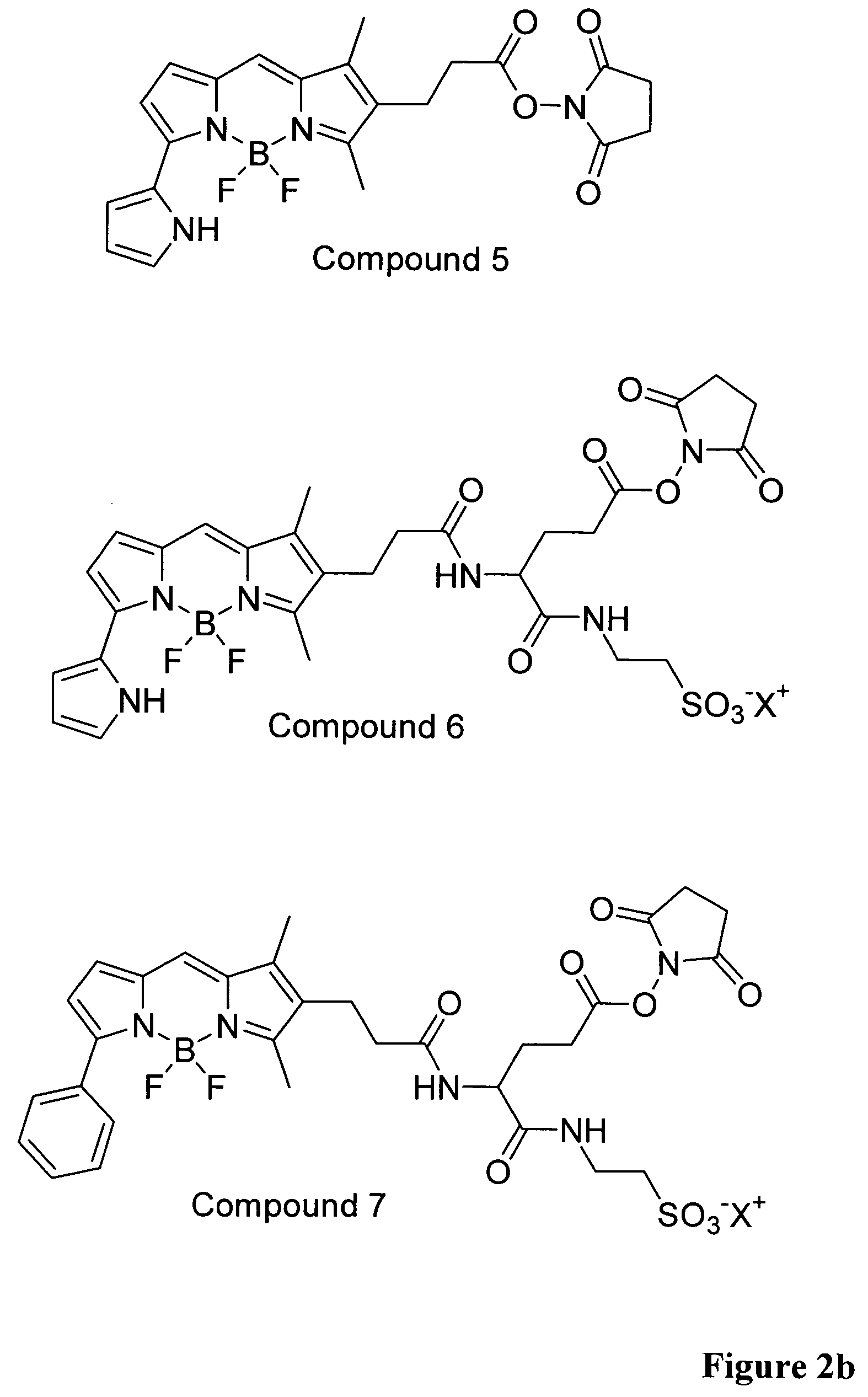Method for increasing hydrophilicity of fluorescent label compounds
a fluorescent label and hydrophilicity technology, applied in the field of fluorescent label compounds, can solve the problems of reducing the photophysical performance of the fluorophore, limiting the use of fluorescent labeling biomolecules, and unwanted precipitation of the labelled conjugate, so as to increase the hydrophilicity and solubility of fluorescent compounds, reduce unspecific binding, and increase the hydrophilicity of fluorescent compounds
- Summary
- Abstract
- Description
- Claims
- Application Information
AI Technical Summary
Benefits of technology
Problems solved by technology
Method used
Image
Examples
example 1
Synthesis of Glu-Tau Linker (1)
[0054]A glutamic acid derivative, BOC-Glu(OtBu)-OSu (Nova Biochem, 500 mg, 1.25 mmol) was dissolved in anhydrous N,N-dimethylformamide (5 ml). Taurine (782 mg, 6.25 mmol) was dissolved in a solution of triethylamine (1.20 ml, 8.75 mmol) and water (10 ml). The taurine solution was added to the solution of BOC-Glu(OtBu)-OSu and the reaction mixture was stirred at room temperature for 30 min. Ethanol was added and the precipitated taurine was filtrated and the filtrate was evaporated to dryness. The residue was dissolved in trifluoroacetic acid (2 ml) and stirred at room temperature for 2 h. The reaction mixture was evaporated to dryness and the residue was dissolved in dichloroethane:methanol. The product was precipitated as a white solid upon slow evaporation of methanol in a rotary evaporator. The desired Glu-Tau linker, compound 1, was obtained in 64% yield (204 mg).
[0055]MS (ZABSpec-oaTOF, Fisons Instruments, glycerol matrix): Calculated 255 (M+1), F...
example 2
Glu-Tau-derivative of 4,4-difluoro-5-(2-thienyl)-1,3-dimethyl-4-bora-3a,4a-diaza-s-indacene-2-propionic acid (3)
[0056]4,4-difluoro-5-(2-thienyl)-1,3-dimethyl-4-bora-3a,4a-diaza-s-indacene-2-propionic acid succinimidyl ester (compound 2) (35 mg, 0.074 mmol) and Glu-Tau-linker (compound 1) (19 mg, 0.074 mmol) was dissolved in anhydrous N,N-dimethyl-formamide (1 ml). Anhydrous triethylamine (31 μl, 0.22 mmol) was added and the reaction mixture was stirred at room temperature for 30 min. The reaction mixture was evaporated to dryness under reduced pressure. The crude product, compound 3, was used without further purification.
[0057]MS (Voyager DE-PRO, MALDI TOF, PerSeptive Biosystems, α-cyano-4-cinnamic acid matrix, negative mode): Calculated 609 (M−1), Found 609 (M−1)
example 3
Glu-Tau-succinimide derivative of 4,4-difluoro-5-(2-thienyl)-1,3-dimethyl-4-bora-3a,4a-diaza-s-indacene-2-propionic acid (4)
[0058]Glu-Tau-derivative of 4,4-difluoro-5-(2-thienyl)-1,3-dimethyl-4-bora-3a,4a-diaza-s-indacene-2-propionic acid (compound 3) (0.074 mmol) was dissolved in anhydrous N,N-dimethylformamide (2 ml). N,N′-dicyclohexylcarbodiimide (46 mg, 0.22 mmol) and N-hydroxysuccinimide (26 mg, 0.22 mmol) were added and the mixture was stirred at room temperature for 48 h. The precipitated N,N′-dicyclohexylurea was filtrated and the filtrate was evaporated to dryness. The product, compound 4, was further dried in a vacuum desiccator and used without further purification.
[0059]MS (Voyager DE-PRO, MALDI TOF, PerSeptive Biosystems, α-cyano-4-cinnamic acid matrix, negative mode): Calculated 706 (M−1), Found 706 (M−1)
PUM
| Property | Measurement | Unit |
|---|---|---|
| pH | aaaaa | aaaaa |
| pH | aaaaa | aaaaa |
| pH | aaaaa | aaaaa |
Abstract
Description
Claims
Application Information
 Login to View More
Login to View More - R&D
- Intellectual Property
- Life Sciences
- Materials
- Tech Scout
- Unparalleled Data Quality
- Higher Quality Content
- 60% Fewer Hallucinations
Browse by: Latest US Patents, China's latest patents, Technical Efficacy Thesaurus, Application Domain, Technology Topic, Popular Technical Reports.
© 2025 PatSnap. All rights reserved.Legal|Privacy policy|Modern Slavery Act Transparency Statement|Sitemap|About US| Contact US: help@patsnap.com



